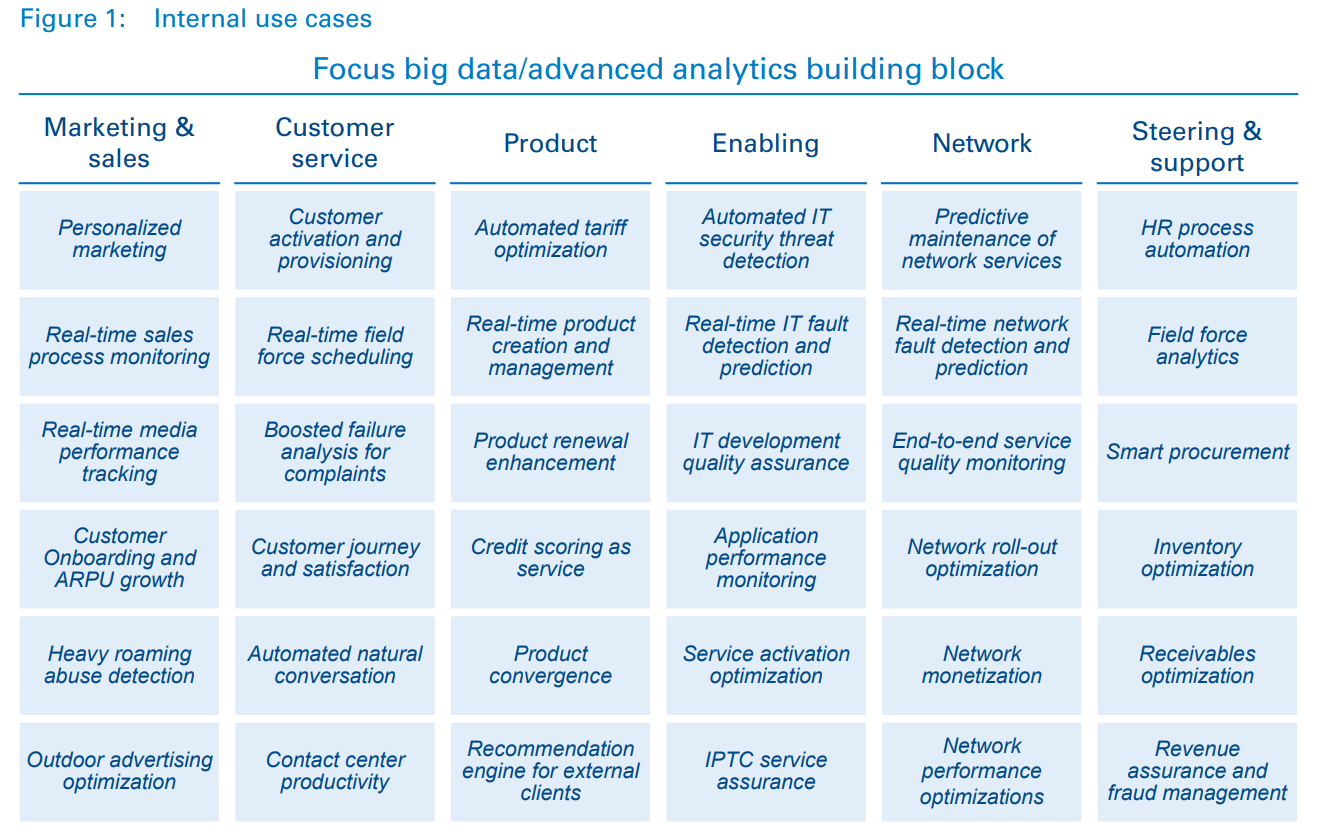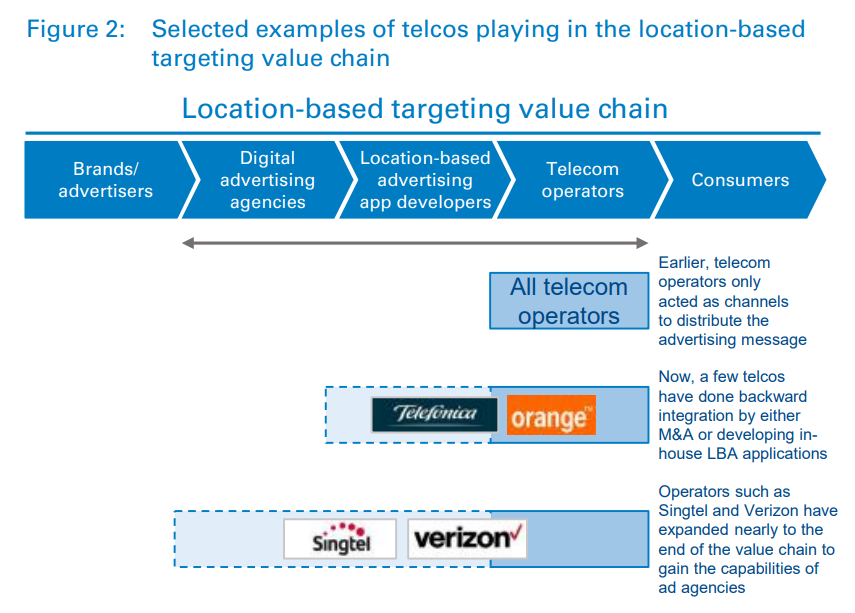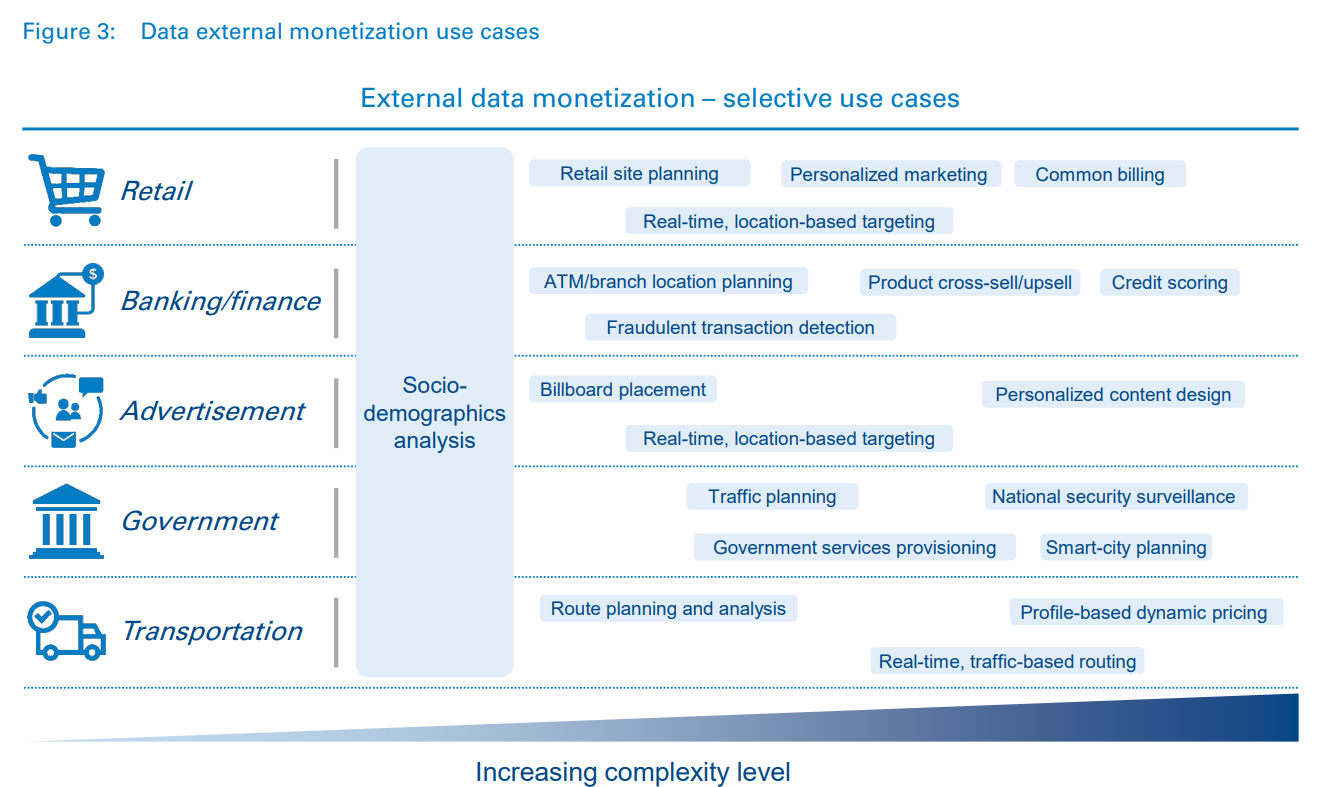Telecoms data monetization: Reality, not a mirage
Big Data can deliver the promise of converting data
into competitive advantage


Executive Summary
Globally, telcos consider data analytics a key strategic pillar, and continue to invest in this direction. However, not many of them have reaped the benefits of these investments, because they face multiple dilemmas around finding the right use cases, making the right technology choices from ever-growing options, and adopting the right operating and governance models to foster data-driven decisionmaking. Our experience of working with multiple telco operators, complemented by interviews with 10+ Chief Data Analytics Officers from leading telcos across EMEA, reveals an addressable approach to these dilemmas. Telcos need to realize that data analytics is a “must-have capability” in this digital age, and related investments will help them survive in the emerging competitive landscape. They need to exploit analytics use cases across their core business functions, in customer facing as well as other areas, such as supply chain, HR and operations. Telcos are uniquely positioned to capture external data monetization opportunities, yet these should be explored on a case-by-case basis, while maintaining a primary focus on internal monetization. Lastly, telco executives must lead efforts to drive organization-wide change to foster data-driven decision-making.
Introduction
Globally, telcos are facing increasing top-line pressure in their core business due to intense competition from market players, as well as the growing threats from digital-native/OTT players. Telcos, thanks to their unique positioning in the ICT value chain, have access to arguably the deepest and richest insights into customers’ behaviors and usage. Leading operators have set up analytics engines and capabilities to manage and process insight about their customers, products, quality of service and internal operations. Today, they are well positioned to enable digital ecosystems around emerging technologies such as artificial intelligence, Internet of Things and block chain. Telcos’ business models in relation to all of these technologies must be enabled by real-time analytics capabilities so data can be processed in an efficient, secure and reliable manner, and with low latency. These ecosystems add new dimensions to the increasing volume, speed and nature of data capture and advanced analytics capabilities. Telcos that are well advanced in their data monetization strategies have developed innovative external partnership models to leverage data for creating innovative products and services in digital ecosystems.
Telcos’ big data journey is not a recent trend; it began in early 2000 with their attempts to develop business intelligence and data warehousing capabilities. The journey before 2005 was based on technologies such as SQL, ETL and OLAP, and mostly limited to the IT landscape. Since 2005, with the advent of “big data” technologies (such as Hadoop), the analytics ecosystem has started to proliferate significantly with respect to technology maturity and supply, data policies and regulations. It has increasingly attracted executive focus and attention.
Several leading telcos have included “building big data and analytics capabilities” as a key strategic pillar, and continue to invest in this direction. However, the benefits of these investments have not been the same for all of them. We believe it is time for telcos to address the following complications when harnessing value from their analytics investments.
- Identifying value pools: A vast number of use cases are constantly appearing on the horizon, but where is the opportunity in the value chain, and which use cases represent the best value creation potential?
- Making technology decisions: A plethora of solutions and technology options are emerging in the data and analytics space. What are the key considerations for technology decision making?
- Choosing the optimal operating model: Different operating model archetypes exist for telcos to build data analytics capabilities in their organizations. What are the key considerations for operating model design in specific contexts?
- Bringing monetization strategy to action: Telcos need to figure out ways to execute data analytics to gain strategic advantage. How can telcos ensure sustainable execution of their big data initiatives?
Analytics value chain – Where are the value pools?
Today, customers are expanding their digital footprints to more and more applications and connected devices. The number of smartphone users has grown around 11 percent per annum in the last few years, and is expected to reach 3 billion by the end of 2020. According to Ericsson, the data traffic per smartphone will grow to 10 times its current volume by 2022. In Europe alone, the data traffic per smartphone will be around 15 GB per month by 2022.
Data has become more structured and data quality has improved significantly, leading to enriched customer databases. These can be used for plug-and-play solutions developed by third parties. Additionally, non-customer related data from internal business functions are presenting equally interesting opportunities to optimize telcos’ internal operations. In this viewpoint, we examine the value and benefits available to telcos from both from internal and external monetization.
Rejuvenate the core business first
Majority of telcos concur on internal/core business being the most tangible and valuable avenue to monetize their data analytics investments. There are numerous use cases of enabling revenue uplift through customer life cycle management and cost optimization through greater efficiency in network planning, sales, customer care, etc.
Telcos with the most advanced data analytics programs have maintained their focus on use cases in their core businesses and operations. For example, a challenger in Eastern Europe has employed a retention strategy using an advanced analytics based anti-churn model and next-best-recommendation engine. It has achieved 58 percent churn reduction in pay TV services and 17 percent in mobile services respectively. Another leading global telco is using customer data to enhance revenue assurance and fraud management. An incumbent in the Middle East combines mobile network probe data and customer information to analyze network quality of service and develop new insight into customer usage patterns. This insight is then used for selective promotional targeting.

The most prevalent use cases among telcos are usually in commercial, network and customer experience processes. A vast number of opportunities in support processes such as HR, procurement and logistics remain largely unexplored. A leading European telco uses analytics techniques to manage procurement activities in massive purchasing operations in order to identify process gaps and deviations from standard procedures. A leading operator in the United States uses a text analytics and machine learning approach applied to customer complaints data to achieve operational efficiency by optimizing the trips of field engineers. An Asian operator responds to rising customer complaints by moving from a reactive to a proactive approach, in which it predicts complaints before customers register them and takes actions to resolve root causes.
Exploit new revenue streams on a case-by-case basis
External data monetization is an advanced stage of a telco data analytics program and should be pursued on a case-by-case basis only. External monetization business models range from merely providing customized data as a service to developing custom products and solutions for third parties. Footfall analytics to track locations of customers and use them for marketing is one of the most popular monetization example for telcos. In many cases, this has enabled operators to diversify in the advertising value chain, either inorganically through acquiring such platforms, or by developing in-house, location-based analytics capabilities.

Some interesting examples of external data monetization are as follows:
Credit scoring as a service: An Eastern European operator leverages internal data to provide “credit-scoring-as-a-service” to external clients. This credit scoring is significantly more effective than a traditional banking model, reducing credit risk by 40 percent as claimed by the operator.
Market Locator: DingoDot has developed an application – “Market Locator” – that enables diverse companies to gain access to powerful analysis based on real hard data. Several European telcos have been using Market Locator to create new revenue streams by providing anonymized and aggregated big data to their B2B customers in the form of a self-service population analytics and mobile marketing solution.
Digital advertising business: A leading US-based operator uses web-browsing history, app usage and location data to personalize rewards and deliver targeted advertising from third parties.
Telecom players, that have taken proactive steps towards external monetization of data, have primarily done so through partnership models across a variety of ecosystems in B2B and B2C segments. In some cases operators have also acquired start-ups for vertical integration across the value chain. Telefonica has engaged in multiple partnerships with leading brands such as Linio, Heineken, and United Colors of Benetton. In 2017, it acquired leading UK geolocation data start-up Statiq. Statiq processes billions of location data signals to identify the places people visit and build consumer profiles. This allows advertisers to better target ads based on a user’s physical location, and track whether the user visited a retail store after seeing a mobile ad.
External data monetization efforts also accentuate the risk of losing customers’ trust because of involuntary privacy breaches. Data privacy is a growing concern for regulators and national security organizations, and efforts to develop robust regulatory frameworks for data privacy are under way in several countries and regions. The European Union has introduced General Data Protection Regulation (GDPR), which gives users the right to protect their own personal data. This forces companies to be more attentive to how they handle customer data and gives users greater control over their data, including the ability to export it, withdraw consent or request access to it. For this reason, telcos should expedite advocacy efforts to shape the regulatory landscape and enable viable business models for the mutual benefit of customers and operators.
We recommend that external data monetization models are thoroughly assessed before resources are dedicated to external monetization efforts. In specific cases of attractive opportunities, telcos should develop partnership models by bringing players in the ecosystem together – customers, users of the data (e.g., B2B clients, start-ups) and intermediate parties (e.g., external analytics firms).
However, despite these developments, there remains general scepticism about external data monetization. Although external monetization opportunities exist, telcos struggle with where and how to start, and as a result find it hard to realize concrete benefits. Most external monetization use cases are local and require well-developed partner ecosystems. Furthermore, external monetization opportunities appear in a range of industry verticals (e.g., mobility, financial services), and telco players face the challenge of finding the appropriate entry points in specific value chains with data analytics offerings.

DOWNLOAD THE FULL REPORT
Telecoms data monetization: Reality, not a mirage
Big Data can deliver the promise of converting data
into competitive advantage

DATE

Executive Summary
Globally, telcos consider data analytics a key strategic pillar, and continue to invest in this direction. However, not many of them have reaped the benefits of these investments, because they face multiple dilemmas around finding the right use cases, making the right technology choices from ever-growing options, and adopting the right operating and governance models to foster data-driven decisionmaking. Our experience of working with multiple telco operators, complemented by interviews with 10+ Chief Data Analytics Officers from leading telcos across EMEA, reveals an addressable approach to these dilemmas. Telcos need to realize that data analytics is a “must-have capability” in this digital age, and related investments will help them survive in the emerging competitive landscape. They need to exploit analytics use cases across their core business functions, in customer facing as well as other areas, such as supply chain, HR and operations. Telcos are uniquely positioned to capture external data monetization opportunities, yet these should be explored on a case-by-case basis, while maintaining a primary focus on internal monetization. Lastly, telco executives must lead efforts to drive organization-wide change to foster data-driven decision-making.
Introduction
Globally, telcos are facing increasing top-line pressure in their core business due to intense competition from market players, as well as the growing threats from digital-native/OTT players. Telcos, thanks to their unique positioning in the ICT value chain, have access to arguably the deepest and richest insights into customers’ behaviors and usage. Leading operators have set up analytics engines and capabilities to manage and process insight about their customers, products, quality of service and internal operations. Today, they are well positioned to enable digital ecosystems around emerging technologies such as artificial intelligence, Internet of Things and block chain. Telcos’ business models in relation to all of these technologies must be enabled by real-time analytics capabilities so data can be processed in an efficient, secure and reliable manner, and with low latency. These ecosystems add new dimensions to the increasing volume, speed and nature of data capture and advanced analytics capabilities. Telcos that are well advanced in their data monetization strategies have developed innovative external partnership models to leverage data for creating innovative products and services in digital ecosystems.
Telcos’ big data journey is not a recent trend; it began in early 2000 with their attempts to develop business intelligence and data warehousing capabilities. The journey before 2005 was based on technologies such as SQL, ETL and OLAP, and mostly limited to the IT landscape. Since 2005, with the advent of “big data” technologies (such as Hadoop), the analytics ecosystem has started to proliferate significantly with respect to technology maturity and supply, data policies and regulations. It has increasingly attracted executive focus and attention.
Several leading telcos have included “building big data and analytics capabilities” as a key strategic pillar, and continue to invest in this direction. However, the benefits of these investments have not been the same for all of them. We believe it is time for telcos to address the following complications when harnessing value from their analytics investments.
- Identifying value pools: A vast number of use cases are constantly appearing on the horizon, but where is the opportunity in the value chain, and which use cases represent the best value creation potential?
- Making technology decisions: A plethora of solutions and technology options are emerging in the data and analytics space. What are the key considerations for technology decision making?
- Choosing the optimal operating model: Different operating model archetypes exist for telcos to build data analytics capabilities in their organizations. What are the key considerations for operating model design in specific contexts?
- Bringing monetization strategy to action: Telcos need to figure out ways to execute data analytics to gain strategic advantage. How can telcos ensure sustainable execution of their big data initiatives?
Analytics value chain – Where are the value pools?
Today, customers are expanding their digital footprints to more and more applications and connected devices. The number of smartphone users has grown around 11 percent per annum in the last few years, and is expected to reach 3 billion by the end of 2020. According to Ericsson, the data traffic per smartphone will grow to 10 times its current volume by 2022. In Europe alone, the data traffic per smartphone will be around 15 GB per month by 2022.
Data has become more structured and data quality has improved significantly, leading to enriched customer databases. These can be used for plug-and-play solutions developed by third parties. Additionally, non-customer related data from internal business functions are presenting equally interesting opportunities to optimize telcos’ internal operations. In this viewpoint, we examine the value and benefits available to telcos from both from internal and external monetization.
Rejuvenate the core business first
Majority of telcos concur on internal/core business being the most tangible and valuable avenue to monetize their data analytics investments. There are numerous use cases of enabling revenue uplift through customer life cycle management and cost optimization through greater efficiency in network planning, sales, customer care, etc.
Telcos with the most advanced data analytics programs have maintained their focus on use cases in their core businesses and operations. For example, a challenger in Eastern Europe has employed a retention strategy using an advanced analytics based anti-churn model and next-best-recommendation engine. It has achieved 58 percent churn reduction in pay TV services and 17 percent in mobile services respectively. Another leading global telco is using customer data to enhance revenue assurance and fraud management. An incumbent in the Middle East combines mobile network probe data and customer information to analyze network quality of service and develop new insight into customer usage patterns. This insight is then used for selective promotional targeting.

The most prevalent use cases among telcos are usually in commercial, network and customer experience processes. A vast number of opportunities in support processes such as HR, procurement and logistics remain largely unexplored. A leading European telco uses analytics techniques to manage procurement activities in massive purchasing operations in order to identify process gaps and deviations from standard procedures. A leading operator in the United States uses a text analytics and machine learning approach applied to customer complaints data to achieve operational efficiency by optimizing the trips of field engineers. An Asian operator responds to rising customer complaints by moving from a reactive to a proactive approach, in which it predicts complaints before customers register them and takes actions to resolve root causes.
Exploit new revenue streams on a case-by-case basis
External data monetization is an advanced stage of a telco data analytics program and should be pursued on a case-by-case basis only. External monetization business models range from merely providing customized data as a service to developing custom products and solutions for third parties. Footfall analytics to track locations of customers and use them for marketing is one of the most popular monetization example for telcos. In many cases, this has enabled operators to diversify in the advertising value chain, either inorganically through acquiring such platforms, or by developing in-house, location-based analytics capabilities.

Some interesting examples of external data monetization are as follows:
Credit scoring as a service: An Eastern European operator leverages internal data to provide “credit-scoring-as-a-service” to external clients. This credit scoring is significantly more effective than a traditional banking model, reducing credit risk by 40 percent as claimed by the operator.
Market Locator: DingoDot has developed an application – “Market Locator” – that enables diverse companies to gain access to powerful analysis based on real hard data. Several European telcos have been using Market Locator to create new revenue streams by providing anonymized and aggregated big data to their B2B customers in the form of a self-service population analytics and mobile marketing solution.
Digital advertising business: A leading US-based operator uses web-browsing history, app usage and location data to personalize rewards and deliver targeted advertising from third parties.
Telecom players, that have taken proactive steps towards external monetization of data, have primarily done so through partnership models across a variety of ecosystems in B2B and B2C segments. In some cases operators have also acquired start-ups for vertical integration across the value chain. Telefonica has engaged in multiple partnerships with leading brands such as Linio, Heineken, and United Colors of Benetton. In 2017, it acquired leading UK geolocation data start-up Statiq. Statiq processes billions of location data signals to identify the places people visit and build consumer profiles. This allows advertisers to better target ads based on a user’s physical location, and track whether the user visited a retail store after seeing a mobile ad.
External data monetization efforts also accentuate the risk of losing customers’ trust because of involuntary privacy breaches. Data privacy is a growing concern for regulators and national security organizations, and efforts to develop robust regulatory frameworks for data privacy are under way in several countries and regions. The European Union has introduced General Data Protection Regulation (GDPR), which gives users the right to protect their own personal data. This forces companies to be more attentive to how they handle customer data and gives users greater control over their data, including the ability to export it, withdraw consent or request access to it. For this reason, telcos should expedite advocacy efforts to shape the regulatory landscape and enable viable business models for the mutual benefit of customers and operators.
We recommend that external data monetization models are thoroughly assessed before resources are dedicated to external monetization efforts. In specific cases of attractive opportunities, telcos should develop partnership models by bringing players in the ecosystem together – customers, users of the data (e.g., B2B clients, start-ups) and intermediate parties (e.g., external analytics firms).
However, despite these developments, there remains general scepticism about external data monetization. Although external monetization opportunities exist, telcos struggle with where and how to start, and as a result find it hard to realize concrete benefits. Most external monetization use cases are local and require well-developed partner ecosystems. Furthermore, external monetization opportunities appear in a range of industry verticals (e.g., mobility, financial services), and telco players face the challenge of finding the appropriate entry points in specific value chains with data analytics offerings.

DOWNLOAD THE FULL REPORT

